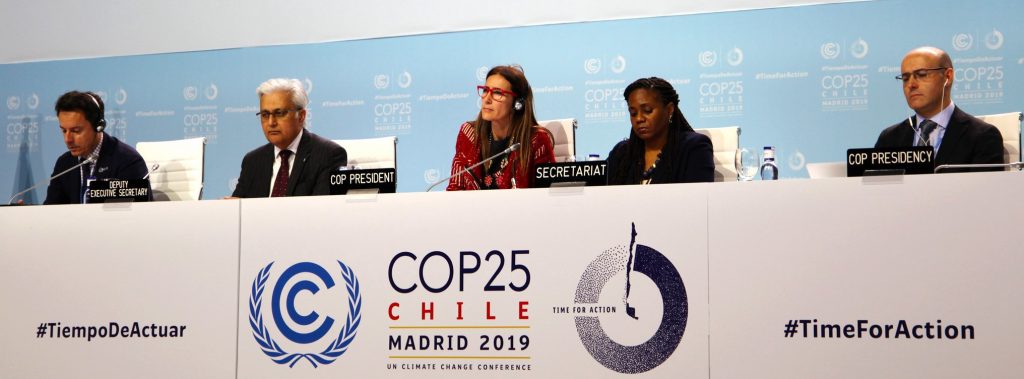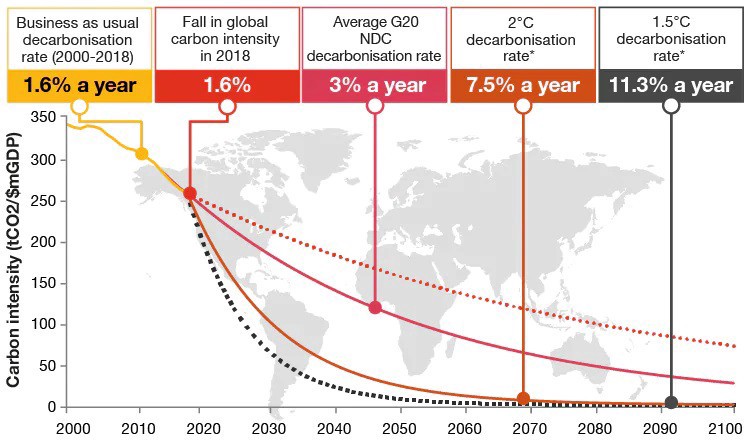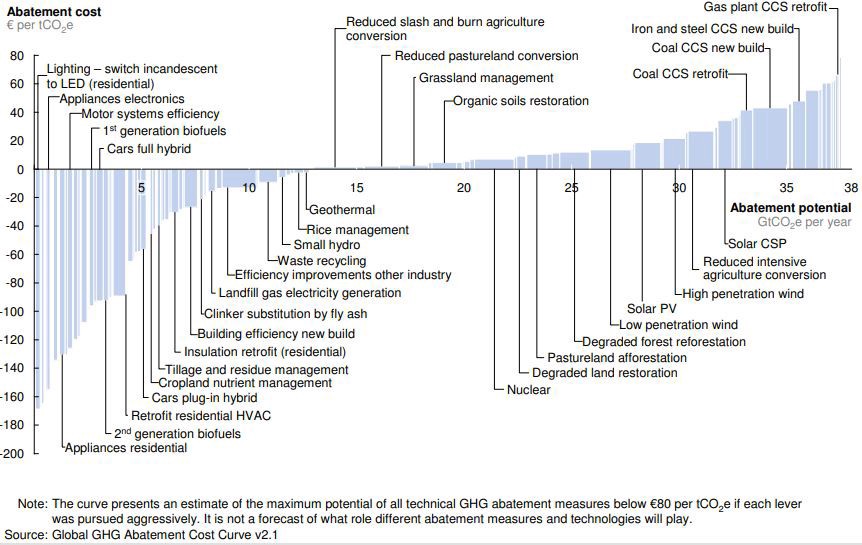We Can’t Count on Cutting Greenhouse Gas Emissions to Prevent Dangerous Climate Change
Although reducing emissions remains essential, it is time to focus on additional responses
Last month, representatives of all countries gathered for their annual meeting to prevent climate change. Despite the motto “Time for Action,” the New York Times described it as “one of the worst outcomes in a quarter-century of climate negotiations.” Should we be surprised? Disappointed? Despairing? I believe that insufficient cuts in greenhouse gas emissions — which is the consistent outcome of nearly three-decades of such climate negotiations — is to be expected and will continue. Yet in the face of the most important contemporary environmental problem, we are relying too much on this single approach at the expense of others. In other words, we have put too many eggs in one basket. Fortunately there are other options.

Human-caused climate change poses serious risks for people and biodiversity. Understandably, the leading response to date has been to reduce (“mitigate”) the emissions of carbon dioxide and other greenhouse gases that cause it. In this regard, there is some good news. Industrialized countries have reduced their emissions by more than 17% since the problem was first identified, despite their growing populations and economies (see emissions data from PBL). Globally, emissions per dollar of economic activity has fallen by 1/3 in that time. Advances in technologies and governance will likely continue these trends. And recent commitments by a few countries and US states to get to net zero emissions imply that policy-makers are finally dedicated to the task.
However, mitigation alone will not prevent dangerous climate change. To be clear, the connection between our greenhouse gas emissions with climate change is well-established, and the risks are grave.
To understand why emissions cuts will not be enough, let’s look at what has been done and what would be needed. Regarding the former, here are a few relevant facts:
- All countries agreed in 1992 to an objective of “stabiliz[ing] greenhouse gas concentrations” in the UN Framework Convention on Climate Change. Since then, emissions have increased 57%
- All countries in 2015 agreed to “reach global peaking of greenhouse gas emissions as soon as possible… and to undertake rapid reductions thereafter… so as to achieve [net zero emissions] in the second half of this century” in the Paris Agreement. Since then, emissions have increased by 4%.
- Germany is often touted as the model country in terms of mitigation. Since the 2010 beginning of its green energy revolution, its emissions have declined by only 2%.
Now let’s turn to what would be needed. Perhaps the best metric is emissions per dollar of economic activity, the so-called the “carbon intensity” of the economy, as this removes confounding changes in population and economic growth. The latest annual Low Carbon Economy Index from the consultancy firm PwC reports that the global economy decarbonizing at an average annual rate of 1.6% since 2000. Yet a 7.5% rate would need to be sustained for decades to have a good chance of staying within the 2 degrees Celsius target, which all countries agreed upon in the Paris Agreement. As a reference point, the highest national decarbonization rate over a decade was France, which reached 4.5% as it rapidly converted to nuclear power from 1979 to 1988.

Although long-term predictions are notoriously difficult, I don’t see any convincing reason to expect the required rapid and sustained turnaround. In fact, existing commitments under the Paris Agreement are forecast to lead to rising emissions through at least 2030. Yes, wind and solar have become less expensive and have grown rapidly (in relative terms), but still constitute just less than 2% of world energy production, and intermittency remains a major challenge to substantial further growth. Yes, awareness of and activism regarding climate change appear to be increasing, but these has not yet resulted in meaningful mitigation. And yes, a few countries and US states have committed to net zero emissions around 2050, but these constitute only 11% of present global emissions. Of course, these are merely targets; the countries might fail to reach them or future leaders might reject them. What’s more, the use of “net” implies reliance on carbon dioxide removal technologies to mitigate the sectors where emissions remain essential, but these technologies may not be able to scale up with acceptable costs and risks.
More generally, theory and practice offer five reasons why meaningful mitigation is — and will continue to be — so difficult. First, it is a global collective action problem, in which it is in the world’s collective interest to mitigate but it is in each country’s individual interest to not do so. Each will then do little, perhaps with the misplaced hope that others will act. In fact, mitigation is worse than a collective action problem: action by some countries increases other countries’ incentives to emit more in order to get a relative advantage in a competitive world economy.
Second, there are no affordable zero-emission substitutes for many important activities. Some mitigation presently has low (or zero) cost because some “low-hanging fruit” — such as energy efficiency and solar panels for daytime electricity — is still available. Once these are “harvested,” costs will increase, possibly rapidly. It remains unclear how to eliminate emissions from, for example, concrete production, agriculture, and air travel. Another consultancy firm, McKinsey, has put these together in a graph that shows mitigation’s increasing costs:

Third, greenhouse gas emissions remain essential to economic activity and thus to improving human well-being. Among the most important responsibilities of policy-makers is to foster economic growth. Although some environmentalists dismiss growth as an unnecessary indulgence of the already-wealthy, this is a blinkered, if not privileged, view that neglects the daily conditions faced by the poor , who constitute a majority of the world’s population. Economic growth increases life expectancy, allows more children to go to school, transforms labor from grueling to tolerable if not enjoyable, and creates the conditions that appear necessary for the fulfillment of human rights.
Fourth, mitigation’s costs are borne now and its benefits are experienced much later. The delayed benefit is because annual emissions and accumulated atmospheric greenhouse gases are large. In contrast, mitigation is a series of small changes that has modest effects on annual emissions and even smaller ones on atmospheric concentrations. You can think of this like steering a large, heavy ship that has a lot of momentum. Turning the wheel — even sharply — will have effects only after some time. This “costs now, benefits later” problem is exacerbated by the fact that changes in transportation, electricity, industry, heating, and agriculture (which together account for most emissions) often require entirely new infrastructures, requiring decades to transform.
Finally, mitigation requires international cooperation but is inexorably bound to divisive international politics. Industrialized countries’ emissions are now decreasing, but those of developing countries are growing rapidly and constitute a majority of global emissions. Although the former argue that everyone needs to do their share, the latter expect to economically develop just as the rich ones have done. Indeed, developing countries’ residents will demand economic growth, and their moral case for this is strong.
Despite the challenges, the large majority of efforts to reduce climate change risks are given to mitigation. Just look at the content of international meetings, national policy, politicians’ rhetoric, academic articles, and the popular press. They consistently talk of the need to cut emissions. But at the end of the day, political leaders will not (and arguably cannot, given voters’ priorities) take actions that bear high costs locally and in the short term, even through they would yield net benefits globally and in the long run. The result is a lot of cheap talk — such as that of “climate emergencies” — and policies that appeal to voters but have little impact — such as subsidies for solar panels. The repeatedly disappointing outcomes of international climate change summits are another predictable consequence.
This narrow focus comes at a cost. We — experts, decision-makers, businesses, and lay people — have only so much effort, money, attention, and other resources. By restricting of our thinking to cutting emissions, we neglect other ways that we can reduce climate risks. Yet a core principle of risk management is diversification: when confronting risks, put your eggs in many baskets, not just one. Three other responses to climate change deserve more attention and dedicated resources.
For one thing, although direct mitigation efforts will bear little fruit, the best path to significant long-term emissions reductions is generous investment in the research and development of low- and zero-carbon energy sources. This way, the country, firm, or other actor that makes the investment stands to benefit through international leadership or profit through bringing in-demand products to market.
As the second additional response, because the climate will change, we should adapt society and — where possible — ecosystems to the expected new conditions. Fortunately, such adaptation largely does not have mitigation’s major challenges, described above. The bad news is that it is expensive, while the people most vulnerable to climate change are poor. Rich industrialized countries arguably should pay for developing countries’ adaptation, but they won’t. Stepping back, if a good predictor of a country’s exposure to climate change risks is its level of economic development, then accelerating it would provide a strong basis for the most vulnerable to adapt to climate change. (This has the additional salutary effect that wealthier people tend to support environmental policies, including mitigation.) Fortunately, developing countries’ rates of economic growth have, on average, been high in recent years. Let’s keep this up.
For the final possible response, it appears that slightly reducing the amount of incoming sunlight by, for example, injecting a fine mist into the upper atmosphere could effectively, inexpensively, and quickly reduce climate change. This “solar geoengineering” would also be imperfect and pose environmental risks and social challenges. In spite of its potential to dramatically reduce climate impacts, global funding for solar geoengineering research is presently less than 0.1% of US federal climate change science and technology funding. (Global numbers for climate science are not readily available, but I estimate solar geoengineering research to be 0.03% of global climate change research.) Research funding for solar geoengineering needs to increase substantially and rapidly. What’s more, the discourse surrounding solar geoengineering is rife with persistent misleading statements and conclusion-driven argumentation. The sooner the conversation allows us to earnestly explore solar geoengineering’s potential and downsides, the sooner our capacities to make well-informed decisions will increase. This is salient, as we might sooner than expected find that climate change impacts have become severe enough that solar geoengineering seems to be a desirable complement to mitigation and adaptation. Yet if we were unprepared, we would face a serious problem.
Cutting and eventually eliminating greenhouse gas emissions remains essential, as it appears to be the only way to genuinely reduce climate change in the long run. Mitigation — as well as the research, development and use of carbon dioxide removal — needs to continue and accelerate, and none of the evidence and arguments presented here justifies opposing it. But in all likelihood, emissions cuts cannot prevent dangerous climate change on their own. I recognize that this message may be unwelcome, particularly among environmentalists. Nevertheless, the time has come to increase investment in zero-carbon energy, adaptation, and solar geoengineering research. Neglecting them increases climate change risks, which fall disproportionately on the world’s poor and on future generations. It might be easy for those of us in the comfortable, lower risk industrialized countries to say that mitigation should remain by far the primary response and to confidently believe that it can prevent dangerous climate change. But we are not the ones who will bear the consequences if this narrow optimism is misplaced.
Reader Comments
4 Replies to “We Can’t Count on Cutting Greenhouse Gas Emissions to Prevent Dangerous Climate Change”
Comments are closed.







Thank you for the new snazzy look, with images! Note, however, that the downloaded PDF is missing all graphics.
Thank you, Jesse, for this informative and sobering analysis of how desperate the situation is. But you omitted an important tool: the economy itself. Fossil fuels are still artificially “cheap,” due of course to their “externalities” not being reflected in their costs.
Since Kyoto, the world has been saddled with an ineffective cap and trade system which has failed to produce the desired results for a number of reasons: price volatility, caps set too high, unforeseen economic events, emissions trading shenanigans, meaningless “offsets” and speculation and ineffectiveness in countries with weak institutions and corruption.
Isn’t it time to try a more effective economic lever, a carbon TAX? It can be predictably rising, acceptable to citizens if all the revenues are returned to their pockets so that they don’t don yellow vests, and a border carbon tariff which incentivizes all trading nations to develop their own carbon tax so as to keep the revenues for themselves.
This is the consensus view of the professional economists in the US, as solid as the scientific consensus. (https://www.econstatement.org) They call for a revenue neutral, fully refunded, predictably rising carbon tax with border carbon tariffs. That’s the only way to globalize carbon pricing, as there’s no other entity on the planet that can do so.
There’s a bill on the House floor, HR 763, the Energy Innovation and Carbon Dividend Act, (https://energyinnovationact.org) with almost 80 sponsors, promulgated by the grassroots Citizens’ Climate Lobby. Several similar bills have been introduced in both House and Senate. Everyone should explore and support them, since it’s clear that without the cooperation of the world economy there’s no chance of success. All of your astute observations above would be assisted by a strong global price signal announcing that humanity is serious about its survival.
Dear Peter,
Thank you for your thoughtful comment. The problem with a national carbon tax is that it would still cost the implementing country through e.g. higher prices for energy and carbon-intensive goods and services. The benefits of reduced emissions would be shared throughout the world and into the future. So it would be another manifestation of the global collective action problem.
In principle, a (nearly) global price on carbon would not have that effect. But it agreeing on and implementing one is very difficult.
If global warming was taken seriously, it might also be a good idea some day to enact a world wide ban on fossil fuel subsidies and tax breaks. https://www.earthtrack.net/sites/default/files/uploaded_files/Koplow_subsidy%20slides%20for%20Synapse%20Webinar%2C%20May%202019.pdf